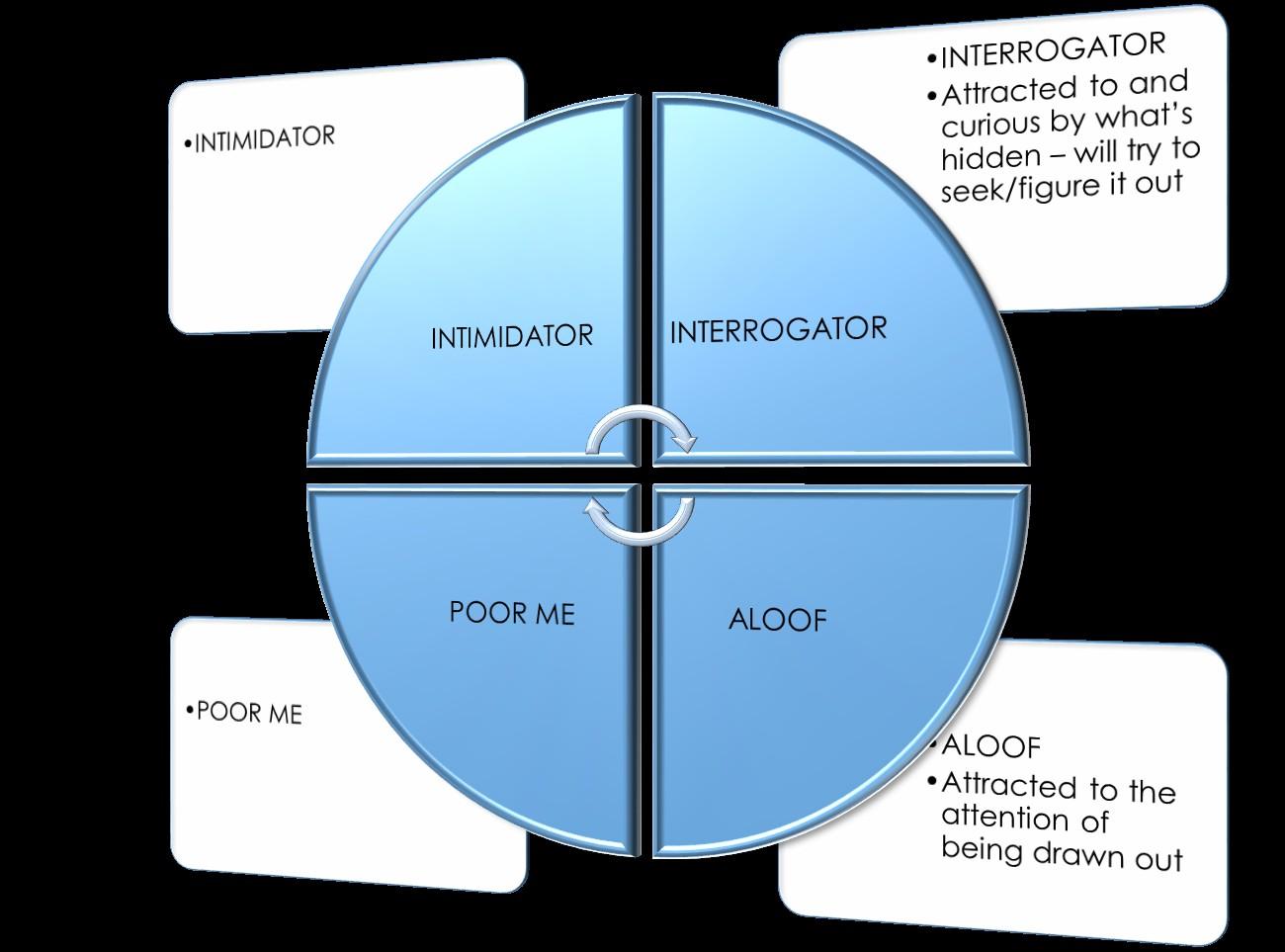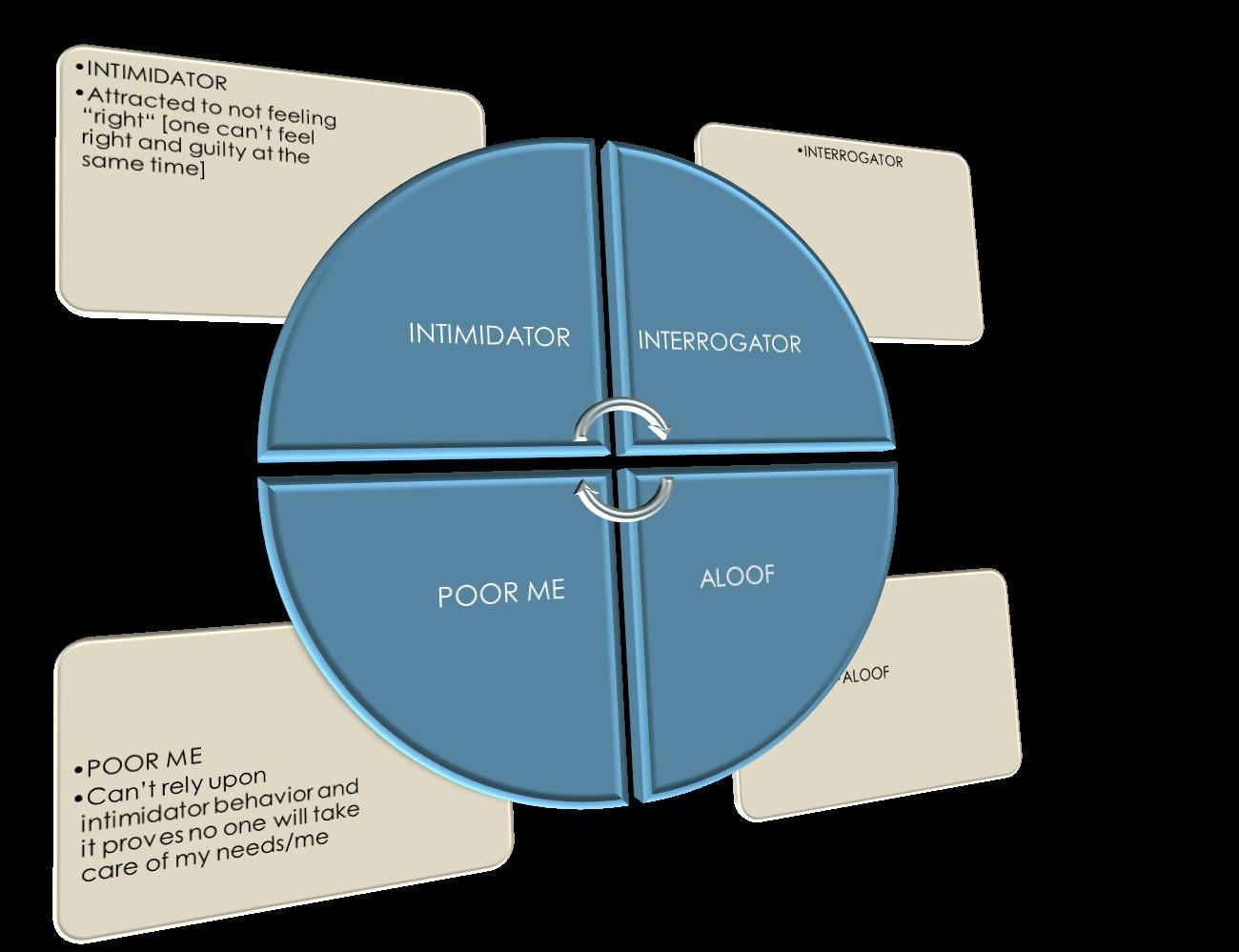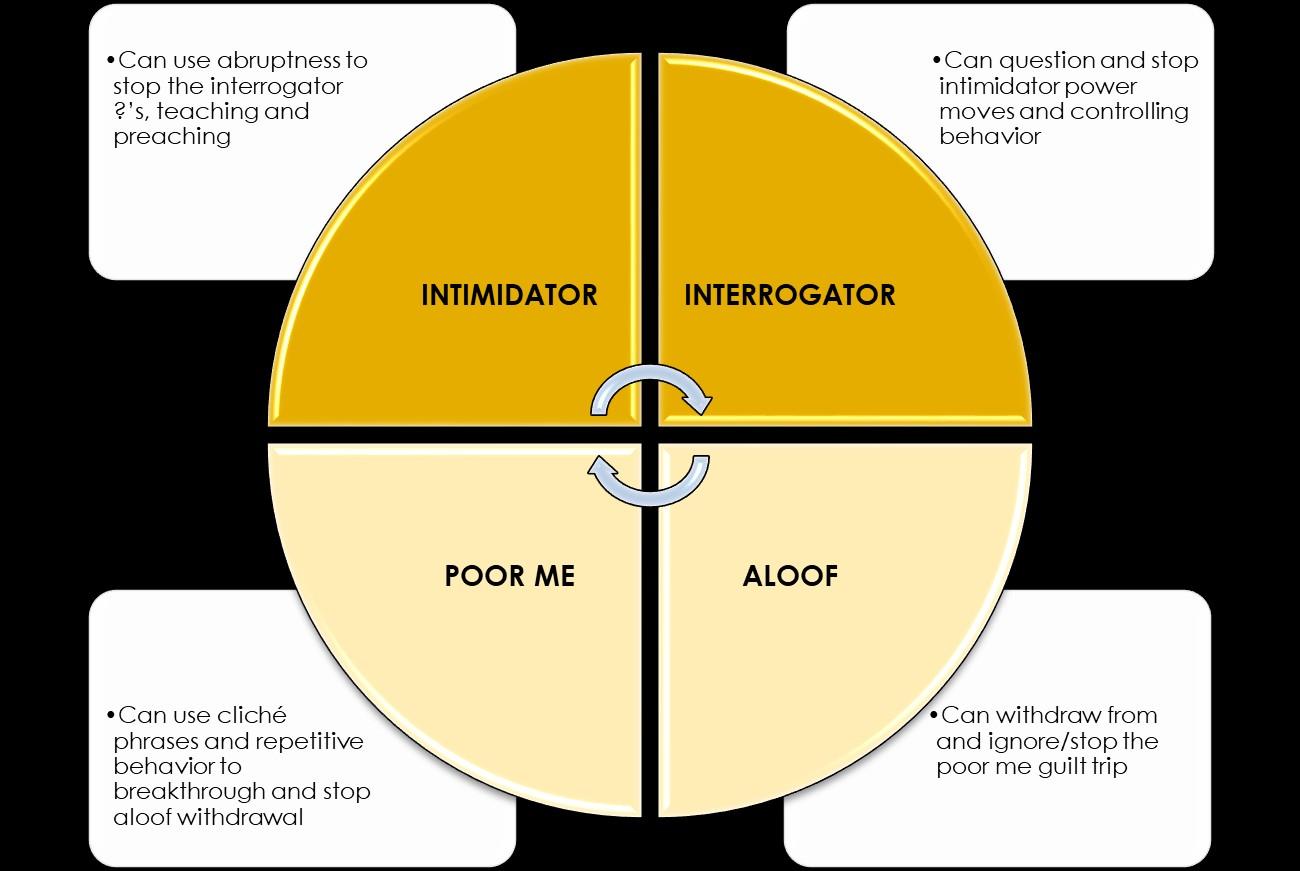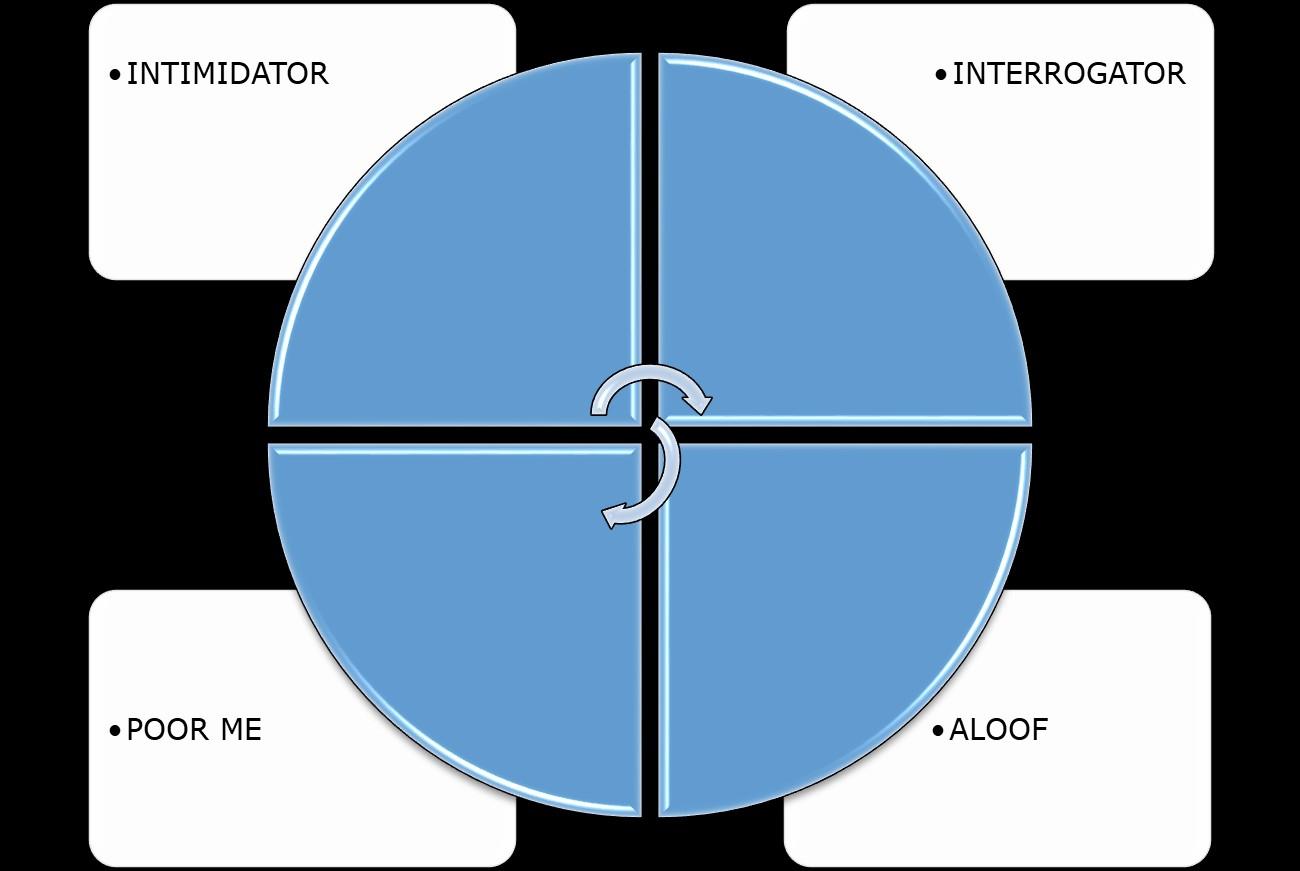








When you know you’ve When you know you’ve experienced this BULLSHIT before! experienced this BULLSHIT before!



“ “People Will Continue to People Will Continue to Be Who They Are, Despite Be Who They Are, Despite Your Opinion of Them!” Your Opinion of Them!”
“I’m not ok; you’re not ok, and it’s ok!”



“ “The More You Understand The More You Understand Someone, the Better You Can Someone, the Better You Can Interact with Them & Forgive Them!” Interact with Them & Forgive Them!”




WHO AM I? WHO AM I?
Let’s take a closer look… Let’s take a closer look…






Cliché – Poor Me
Fact – Intimidator
Opinion – Interrogator
Emotion - Aloof


Common Communication Patterns Their Life Perspective/Fears
How You Feel in their Presence Power Moves that Work for Them Attraction/Alliances/Non Compatible Predictable Conflict Cycles
How to Best Work with their Drama


Approach: Approach: Do It Now – Get it Done Do It Now – Get it Done
Tone: Tone: “Get to the Point” “Get to the Point” They Lead with Facts They Lead with Facts
Goal: Goal: Personal Achievement and Personal Achievement and Meeting Challenges Meeting Challenges
Intention: Intention: Wants Inner Certainty & Wants Inner Certainty & Focuses on Action Focuses on Action
Seen As: Seen As: Impatient, Rude, Critical Impatient, Rude, Critical
Should: Should: Learn to Learn to Complain without Blame Complain without Blame
▪ Quick to argue or yell
▪ May pick a fight or bad mouth you
▪ Communication has an arrogant tone
▪ Attempts to control
▪ Prone to unexpected outbursts
▪ Self-obsessed – it feels like they want “center stage”
▪ Stand too close/corner you
▪ Discomfort in their presence [uneasy]
▪ Their “truth” is often felt as an insult
▪ As message of entitlement
▪ A feeling of being drained
▪ Exhaustion or lack of energy
▪ An unsafe or threatening tone
▪ The lack of control


▪“Do this for me”
▪“I guarantee you that…”
▪“Here’s what really happened”
▪“I am just telling the truth/being honest”
▪Breaks the other’s spirit, “why would anyone want that job?”
▪“Me first”
▪Statements are often framed in the negative
▪An intimidator sticks to conversations concerning the facts
▪Steals their “thunder” - interrupts with “let me tell you what really happened…”
▪Creates a threatening atmosphere




Approach: Approach: Do It Now – Get it Done Do It Now – Get it Done
Tone: Tone: “Get to the Point” They Lead with Facts “Get to the Point” They Lead with Facts
Goal: Goal: Personal Achievement and Personal Achievement and Meeting Challenges Meeting Challenges
Intention: Intention: Wants Inner Certainty & Wants Inner Certainty & Focuses on Action Focuses on Action
Seen As: Seen As: Impatient, Rude, Critical Impatient, Rude, Critical
Should: Should: Learn to Learn to Complain without Blame Complain without Blame
▪ Quick to argue or yell
▪ May pick a fight or bad mouth you
▪ Communication has an arrogant tone
▪ Attempts to control
▪ Prone to unexpected outbursts
▪ Self-obsessed – it feels like they want “center stage”
▪ Stand too close/corner you
▪ Discomfort in their presence [uneasy]
▪ Their “truth” is often felt as an insult
▪ As message of entitlement
▪ A feeling of being drained
▪ Exhaustion or lack of energy
▪ An unsafe or threatening tone
▪ The lack of control


▪“Do this for me”
▪“I guarantee you that…”
▪“Here’s what really happened”
▪“I am just telling the truth/being honest”
▪Breaks the other’s spirit, “why would anyone want that job?”
▪“Me first”
▪Statements are often framed in the negative
▪An intimidator sticks to conversations concerning the facts
▪Steals their “thunder” - interrupts with “let me tell you what really happened…”
▪Creates a threatening atmosphere


Destructive Communication Strategies
Destructive Communication Strategies
▪▪Criticizing - “you always/you never…” Criticizing - “you always/you never…”
““you are the most stubborn...” you are the most stubborn...”
▪▪Judging - “that’s the craziest idea…” Judging - “that’s the craziest idea…”
“ “I guarantee you that this will not work…” I guarantee you that this will not work…”


Competing Conflict Response Style
Competing Conflict Response Style
During an intense interaction, the interpersonal style of During an intense interaction, the interpersonal style of conflict you will typically find coupled with intimidator behavior conflict you will typically find coupled with intimidator behavior is competition. Competitive messages include feelings of is competition. Competitive messages include feelings of “Might makes right” “Might makes right” and like a shark, competitors are and like a shark, competitors are willing to use force when needed. willing to use force when needed.

▪Intimidators will experience the lack of feedback and indecision from others
▪Intimidators will have reduced learning, as others withhold information from them
▪Intimidators usually take the lead/do and the result is low empowerment of others
▪Intimidators find themselves surrounded by “yes people” who are slow to act

▪They don’t have to look at themselves or work on their own issues because everyone else is wrong and only the others need to change.
▪They create fear in others and thus are able to fulfill a personal need.
▪They get to be in a position where no one will approach them or “burden” them for anything.
▪They get to be right at the expense of others being wrong and get to police them.
▪They get to decide for everyone and therefore get their way.
An Intimidator Values An Intimidator Values
Apologies Apologies

An Intimidator should An Intimidator should stay still and focus on stay still and focus on his/her breathing his/her breathing

▪Avoid putting yourself in a position where you must rely on an intimidator [advice, a loan, carpooling]

▪Ask directly about their need to repeat their point after you’ve expressed yours
▪Avoid the compulsion to defend yourself by meeting their behavior with silence
▪Choose to frame conversation


Approach: Approach: Do It Harmoniously Do It Harmoniously
““We’re in This Together We’re in This Together
Tone: Tone: “Care about Me” They Lead with “Care about Me” They Lead with Cliché Statements Cliché Statements
Goal: Goal: Harmony Harmony
Intention: Intention: Wants Stability & To Support Others Wants Stability & To Support Others
Seen As: Seen As: Accommodating, Guilt Ridden, Docile Accommodating, Guilt Ridden, Docile
Should: Should: Learn to Take Responsibility & Own It Learn to Take Responsibility & Own It
▪Looks worried and sighs often
▪Speaks slower than you when you speak
▪A sense of guilt
▪An obligation to help
▪A responsibility to accommodate their needs
▪Mentions their unfortunate experiences
▪When help is offered they reject it
▪Discusses the same topic with you often
▪Pity for them
▪A feeling that they need you
That they exhibit little responsibility for their actions


▪Retells the same drawn out stories

▪“Yeah, but…” – agrees then denies
▪Gets attention by eliciting pity or guilt
▪Thrives in drama or when rehashing a problem
▪A poor me sticks to conversations concerning cliché statements [what a nice day; this is some weather we’re having hey?]
▪May intentionally procrastinate, forget, sulk or communicate a personal inefficiency
▪Creates a sense of obligation for you
▪Defensiveness [used to protect themselves against pain, fear, etc.]
▪Whining, deflecting, denying or further defending
▪Minimizing - “you’ll make it work…”
“Don’t worry, I am fine, this will pass.”

During an intense interaction, the interpersonal style of conflict you will typically find coupled with poor me behavior is accommodation.
Accommodating messages include feelings of

▪Others will choose to have a surface level relationship with you

▪Poor me's will not be included in the decision making process
▪People experience poor me behavior as sneaky and/or snide
▪People will give the poor me’s ideas very little attention once expressed

▪They don’t have to be responsible for what’s happening to them.
▪They can control others with guilt, pity and obligation to fulfill a personal need.
▪They feel automatic self-esteem/self-worth as people give attention to them and their issues.
▪They get others to do things for them and therefore they don’t have to carry the burden.
A Poor Me Values A Poor Me Values
Shared Struggles = Shared Struggles =
““We are in this together” We are in this together”

A Poor Me should A Poor Me should express themselves express themselves through talking, writing, through talking, writing, singing, etc singing, etc.

▪Ask directly about their reluctance to let you help them

▪Directly tell them that you are more interested in solving their problems then continuing to rehash them
▪Assure them you have chosen to hold positive thoughts for them as they work through their


Approach: Approach: Do It Right Do It Right
Tone: Tone: “Give Me Details” “Give Me Details” They Lead with Opinions They Lead with Opinions
Goal: Goal: To Gain Understanding, To Help To Gain Understanding, To Help Intention: Intention: Wants to be Correct, Have High Standards Wants to be Correct, Have High Standards
Seen As: Seen As: Analytical, Distant, Critical Analytical, Distant, Critical
Should: Should: Learn to Build Appreciation & Respect Learn to Build Appreciation & Respect
▪Probes and instructs
▪Must do it “their way”
▪Suggests you aren’t capable
▪Sounds like a know-it-all
▪Teaches and preaches
▪Needles then offers self-righteous messages
▪You “don’t meet their standards”
▪A feeling of being monitored
▪Your feelings are invalid
▪Failure to meet their standards
▪Being cast into the role of “inadequate”
▪A message that “you can’t handle it”
▪A message regarding how you “should” feel


▪“Why?” followed by infallible logic
▪“You should…I am just trying to help”

▪“Did you ever consider…”
▪“Here’s what I did when that happened”
▪Questions your every act or motive
▪Dominates a conversation with questions
▪Turns the topic of conversation back to them
▪An interrogator sticks to conversations concerning opinions
▪Scrutinizes your decisions/gives you pause
▪Contempt - mockery, put-downs, hostile corrections, which may be coupled with sarcasm, ridicule, demeaning tone and outright joking.
“How hard is it to xyz?”
▪Preaching - “Here’s your problem and here’s what I would do if I were you.”

During an intense interaction, the interpersonal style of conflict you will typically find coupled with interrogator behavior is compromise. Compromising messages include feelings of “Let’s share” and like a fox, compromisers are willing to find a clever

▪Interrogators often lose the big picture because they get caught up in details
▪Interrogators experience a lack of trust from those around them

▪Interrogators may find themselves in a cynical climate

▪They get to be right and more knowledgeable then everyone around them.
▪They are able to make people doubt themselves and thus gain some personal power.
▪They feel self-worth by focusing on others mistakes and faults and then get to avoid their own problems.
▪They force others to need and rely upon their approval by questioning every move others make.
An Interrogator An Interrogator Values Values
Hearing and Hearing and Speaking the Truth Speaking the Truth

An Interrogator should An Interrogator should quiet his/her mind quiet his/her mind and be still and be still

▪Ask directly about their reason for questioning you

▪Respond to their questions with questions [why do you ask, what do you mean]
▪Make certain topics off limits
▪Request they delegate tasks to you/others 42


Approach Approach: Let’s Do It Together : Let’s Do It Together
Tone: Tone: “Involve Me” – They Lead with Emotion “Involve Me” – They Lead with Emotion
Goal: Goal: Meaningful Interaction and Meaningful Interaction and to Have Fun to Have Fun
Intention: Intention: Wants Recognition & Respect Wants Recognition & Respect
Seen As: Seen As: Disorganized, Unavailable & Preoccupied Disorganized, Unavailable & Preoccupied
Should: Should: Learn to Self Soothe & Cope Learn to Self Soothe & Cope
▪Passive behavior
▪Comes off detached and unaffected
▪Tends to walk away
▪Needs a lot of space or “me” time
▪Resists being pinned down
▪Difficulty making up their minds
▪Likes privacy and low commitment
▪Is distant or unapproachable
▪A lack of disclosure about common information
▪A threat of being left or abandoned
▪Vagueness/unresponsive behavior
▪They are “preoccupied”
▪A lack of concern or apathy
▪Little to no interest in you
▪They are being secretive
▪You must “work” for information


▪“It doesn’t matter; I don’t care”

▪“I am no threat; you can decide”
▪Appears mysterious to be drawn out
▪An aloof sticks to conversations concerning their experiences and/or their emotions
▪Forces others to engage in an undeserved investment of energy to gain commitment, information and emotion, which is usually shared in a direct way by others
▪When approached, they retract
▪Stonewalling - withdrawing from the interaction, appearing stiff, glancing away
▪Indifference - “whatever works; you decide; it doesn’t matter to me.”

During an intense interaction, the interpersonal style of conflict you will typically find coupled with aloof behavior is avoidance.
Avoiding messages include feelings of, “Let’s leave well enough alone” and “I’ll think about it tomorrow” and like a turtle, avoiders are willing to withdraw from an interaction.

▪An aloof will experience things they don’t want as decisions are made by default when opinions aren’t openly expressed

▪An aloof will often encounter issues and problems that fester
▪An aloof will create a cautious climate where people withhold information as to not offend them.
▪They get to withdraw and gain self-worth as you try to draw them out and focus your attention on them.
▪They don’t have to be burdened by helping others decide or express opinions or ideas because others have learned not to ask.

▪They aren’t able to be hurt or controlled by others because as they distance themselves from honest emotional contact and often avoid meaningful interactions altogether.
When they are asked When they are asked questions and questions and uninterrupted [other uninterrupted [other than “why”] than “why”]

An Aloof move and An Aloof move and do something do something

▪Ask directly about their reluctance to respond to you

▪Avoid defensive behaviors, as it will fuel their anxiety and fear around mistrusting and they will further withdraw
▪Name their game by specifically describing their behavior; they will either admit to the













Friend/Alliance
Attraction | Compatibility Attraction | Compatibility No Way

Friend/Alliance


Will you choose to REACT [cause & effect] to a control drama or CREATE [cause the effect] an effective response?


